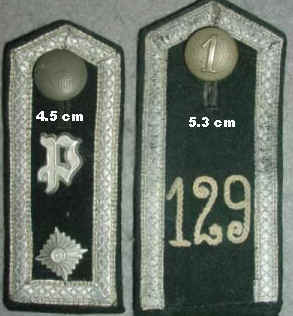David A. Suter for Wehrmacht-Awards.com
Enlisted Shoulder Straps
Basic designs:
There were two patterns of shoulder straps used during the Third Reich period. The 1st Pattern initially closely resembled the straps of the Imperial German Army (Photo 1). The button end was pointed and there was no Waffenfarbe piping. They were first made of basic uniform cloth, but on 10 December 1934 this was changed to field grey badge cloth. Less than a year later, on 10 September 1935 this was again changed to bluish-dark green badge cloth (Photo 2). Any embroidered numbers or ciphers were done in the appropriate branch color (Photo 3).
 |
 |
 |
| Photo 1 | Photo 2 | Photo 3 |
The 2nd Pattern was introduced on 26 November 1938. This strap had a rounded button end and branch color piping. It too was constructed of bluish-dark green badge cloth
(Photo 4).
Interestingly enough, there is an overlap period, as the 1st Pattern strap was permitted to be produced until 18 March 1939. The final official change came in May 1940 when the color was again changed, this time back to basic field grey uniform cloth. Subdued tress was usually used with these straps
(Photo 5), but not always (Photo 6).
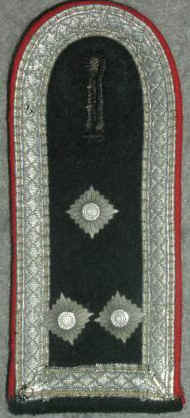 |
 |
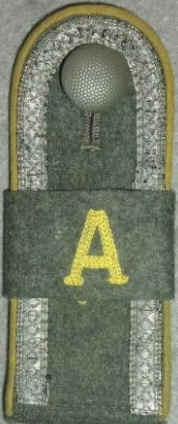 |
| Photo 4 | Photo 5 | Photo 6 |
In addition special straps were produced for the HBT (Photo 7), panzer (Photo 8), and tropical uniforms
(Photo 9).
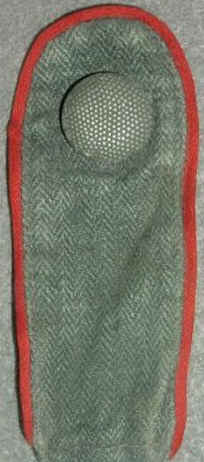 |
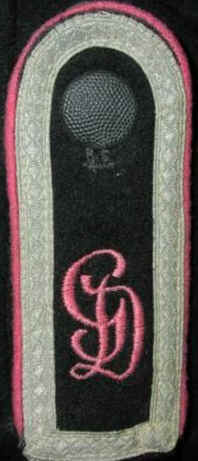 |
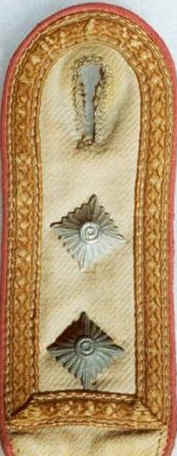 |
| Photo 7 | Photo 8 | Photo 9 R. Heinz Collection |
For the most part, only the colors and/or materials differentiated these from their 'Continental' brothers. HBT and Tropical straps typically were devoid of any unit designators.
As such, it is possible to get a general time frame of production based on the design of a particular strap.
Note, however, that while production periods of the various styles of straps were changed, the wear of 'outdated' styles was not forbidden.
Branch piping materials:
Initially, the branch piping was made of wool badge cloth (Photo 9a). This was soon supplemented by the use of a woven artificial silk (Rayon) material (Photo 9b). As the photo shows, the latter has a distinctive woven pattern. On occasion, a variant ribbed or corded material will be encountered (Photo 9c).
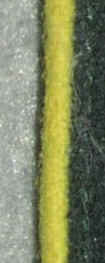 |
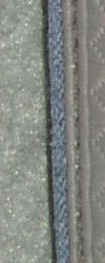 |
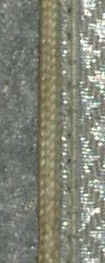 |
| Photo 9a | Photo 9b | Photo 9c |
Sizes:
By regulation, shoulder straps were produced in two widths. The 'standard' width was 4.5 cm (1 ¾"). If the strap needed to accommodate a three-digit number, the width was 5.3 cm (slightly over 2") (Photo 9d). The length of the strap was determined by the size of the soldier. The strap was to extend from the shoulder head seam to 2 cm (¾") from the edge of the collar.
|
|
|
Photo 9d |
Tress:
The rank of Unteroffizier and above was distinguished by the use of NCO tress and rank pips. Several patterns of tress are encountered. The earlier Weimar or Reichswehr-type tress has a checkered pattern and is identical to the tress used on Luftwaffe straps (Photo 10).
On 10 September 1935 this pattern was changed to one with a single row of diamonds down the center (Photo 11). Both these types were made of bright silver. On 25 April 1940 a subdued field grey tress made of artificial silk was introduced (Photo 12), as well olive-drab or copper-brown for use on tropical straps (Photo 13). The pattern was the same. It is not too uncommon to find the early checkered pattern of tress used on a 2nd pattern strap (Photo 13a).
 |
 |
| Photo 10 | Photo 11 |
 |
 |
| Photo 12 |
Photo 13 S. Pritchett Collection |
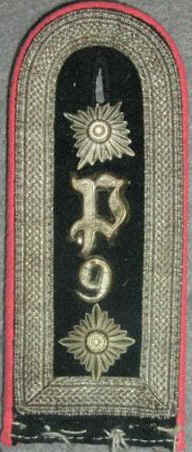 |
 |
| Photo 13a | Photo 14 |
Button holes:
The most commonly-encountered button holes are done in the 'keyhole' style
(Photo 14). Button holes executed in the simpler 'slit' style are also encountered
(Photo 15).
|
|
|
Photo 15 |
Attachment methods / construction:
Shoulder straps were attached to the uniform in one of two ways: they were either sewn directly into the head seam or they were detachable by use of a tongue. The backs of shoulder straps were lined with scrap material. It is very common to find seams in the material (Photo 16). The tongues were sometimes of the same material as the strap top but were frequently of a different material. The back of the tongue strap was usually lined. This lining could have been made of just about anything, from artificial silk (Photo 18) to various cotton twill materials (Photo 19). Later in the war (1944) the backing material of straps was eliminated as an economy measure (Photo 19a). Shoulder straps were frequently privately tailored, so a wide variety of materials and craftsmanship will be encountered. It must also be mentioned that earlier straps which began life as sew-ins were often removed from the tunic's head seam (Photo 19b) and turned into a detachable strap by the addition of a tongue (Photo 19c), as the front and back of this strap clearly illustrates.
 |
 |
| Photo 16 S. Pritchett Collection |
Photo 18 |
|
|
|
|
Photo 19 |
|
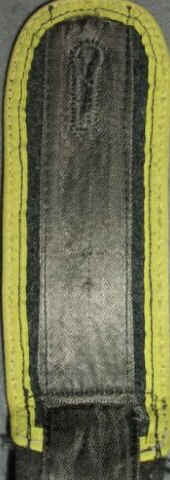 |
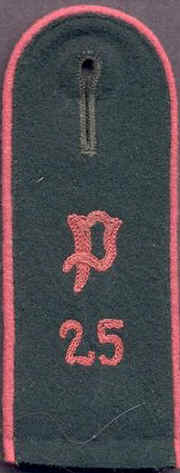 |
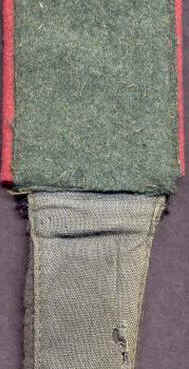 |
| Photo 19a | Photo 19b S. Pritchett Collection |
Photo 19c S. Pritchett Collection |
Specialist Senior NCOs:
In two instances NCOs wore shoulder boards instead of straps. These boards are two of the more interesting pieces of insignia. First are the boards worn by a Fortress Shop Foreman. The cords that make up the boards were a bright orange-red with an aluminum center stripe. The board would have one or two rank pips and an aluminum Fp device in the center. The base underlay was black (Photo 20). Next are the boards worn by the Farrier. The design was the same as the Fortress Shop Foreman but the cords were golden yellow instead and the base underlay was crimson. This board had an aluminum horseshoe device along with the rank pip(s) (Photo 21).
 |
 |
| Photo 20 | Photo 21 D. Schreiber Collection |
![]()
© Copyright Wehrmacht-Awards.com LLC |

